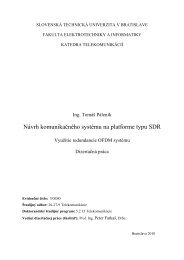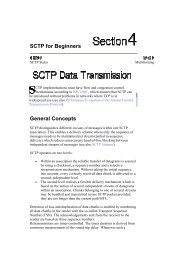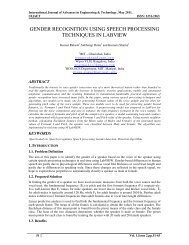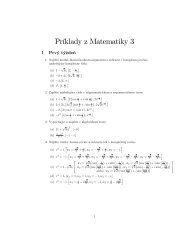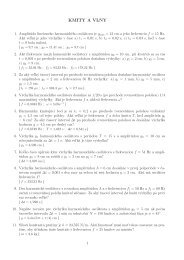05 SCTP for Beginners SCTP Multihoming.pdf
05 SCTP for Beginners SCTP Multihoming.pdf
05 SCTP for Beginners SCTP Multihoming.pdf
- No tags were found...
Create successful ePaper yourself
Turn your PDF publications into a flip-book with our unique Google optimized e-Paper software.
<strong>SCTP</strong> <strong>for</strong> <strong>Beginners</strong><strong>SCTP</strong> Data<strong>SCTP</strong> Streamsn essential property of <strong>SCTP</strong> is its support of multi-homed nodes,i.e. nodes which can be reached under several IP addresses. If the<strong>SCTP</strong> nodes and the according IP network are configured in such a waythat traffic from one node to another travels on physically differnt pathsif different destination IP address are used, associations become tolerantagainst physical network failures and other problems of that kind.Address Management at AssociationSetupIf a client is multi-homed, it in<strong>for</strong>ms the server about all its IP addresseswith the INIT chunk's address parameters. Thereby, the client is onlyrequired to know one IP address of the server because the server providesall its IP addresses to the client in the INIT-ACK chunk. <strong>SCTP</strong> is able tohandle IP version 4 and IP version 6 addresses (even mixed). An <strong>SCTP</strong>instance regards each IP address of its peer as one ``transmission path''towards this endpoint.If no explicit IP addresses are contained in the INIT or INIT-ACK chunk,the source IP address of the IP packet which carries the <strong>SCTP</strong> datagramis used. This eases application of <strong>SCTP</strong> when Network AddressTranslation, (NAT), e.g. at the edge of large privat IP networks, isinvolved. To facilitate this further, an additional optional feature has beenintroduced into the RFC2960 which allows the usage of host names inaddition to or instead of IP addresses.Path and Peer MonitoringAn <strong>SCTP</strong> instance monitors all transmission paths to the peer instance ofan association. To this end, HEARTBEAT chunks are sent over all pathswhich are currently not used <strong>for</strong> the transmission of data chunks. EachHEARTBEAT chunk has to be acknowledged by a HEARTBEAT-ACKchunk.
Each path is assigned a state: it is either active or inactive. A path isactive if it has been used in the recent past to transmit an (arbitrary)<strong>SCTP</strong> datagram which has been acknowledged by the peer. Iftransmissions on a certain path seem to fail repeatedly, the path isregarded as inactive.The number of events where heartbeats were not acknowlegded within acertain time, or retransmission events occurred is counted on a perassociation basis, and if a certain limit is exceeded (the value of whichmay be configurable), the peer endpoint is considered unreachable, andthe association will be terminated.Path SelectionAt the set-up of an <strong>SCTP</strong> association, one of the IP addresses from thereturned list is selected as initial primary path. Data chunks aretransmitted over this primary transmission path by default. Forretransmissions however, another active path may be selected, if one isavailable. To support the measurement of round trip delays, SACKchunks should be sent to the source address of the IP packet whichcarried the data chunk that triggered the SACK.The users of <strong>SCTP</strong> are in<strong>for</strong>med about the status (state andmeasurements) of a transmission path on request or when a transmissionpath changes its state. They may then instruct the local <strong>SCTP</strong> instance touse a new primary path.



